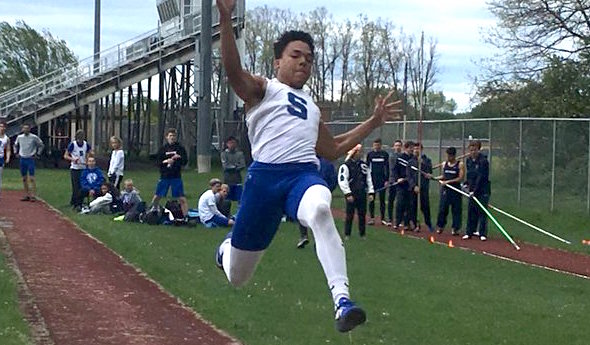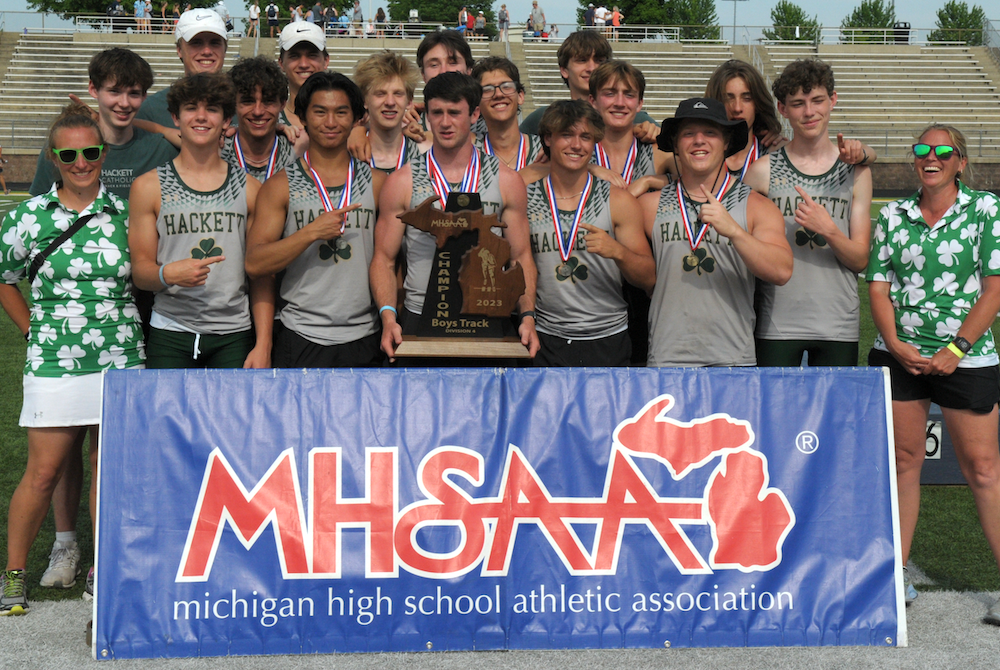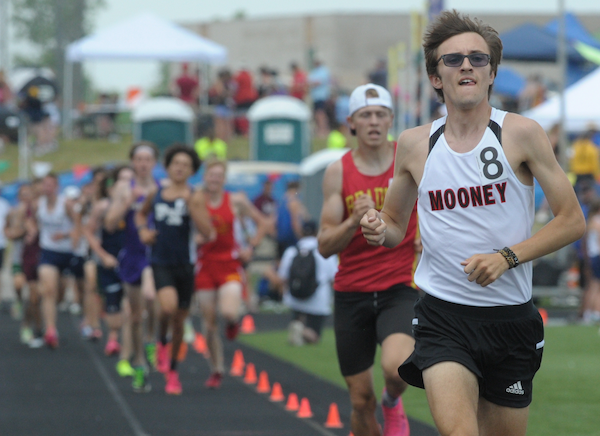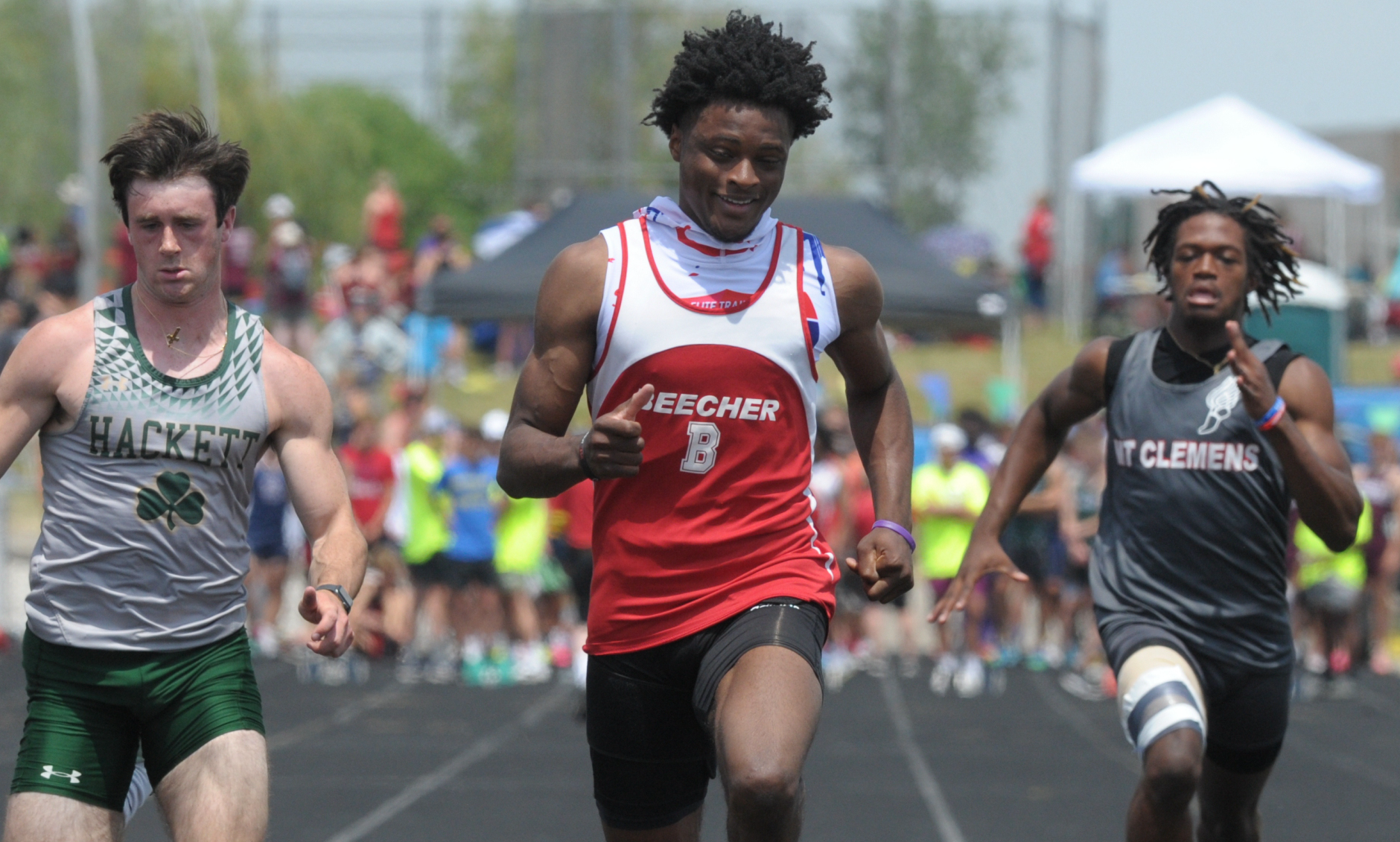
Performance: Salem's Mason Phillips
May 13, 2017
 Mason Phillips
Mason Phillips
Salem senior – Track & Field
Over the last week, Phillips has emerged from a key contributor to Salem’s No. 3-ranked boys track & field team to become one of the most incredible stories of this spring season. A four-year football player for the Rocks, Phillips had run track as a freshman but not the last two years before coming back to the team this spring – and at the May 6 New Balance Invitational at Farmington unloaded a wind-aided long jump of 24 feet, 1 inch, vaulting him into MHSAA title discussion and earning him the Michigan Army National Guard “Performance of the Week” for May 1-7.
Phillips took up long jumping a mere three weeks ago – to help his team score some points when one of its long jumpers was out – but if he can replicate that 24-1 jump without the wind at next month’s Lower Peninsula Division 1 Finals, he would tie the all-Finals record set in 2009. Phillips actually set the school record previously with a 22-10¾ leap at the April 29 Brighton Invitational. At Farmington, he also set a school record in the 200 meters at 22.07 seconds (and since broke it again going 22.06 at Friday’s Kensington Lakes Activities Association championship meet). He also runs on undefeated 400 and 800 relay teams.
 A wide receiver in football, Phillips caught track coach Dale Maskill's attention pulling in athletic one-handed catches during warm-ups in the fall – and is a different athlete than the one who ran his only other season of track as a 4-foot-11 freshman. Phillips has since grown a foot, and his newfound talents are opening up opportunities as well. He received Division III college interest for football but was set on attending Bowling Green State University and possibly studying sports medicine. But he’s now getting interest from college track & field coaches – and should keep turning more heads as this season finishes up.
A wide receiver in football, Phillips caught track coach Dale Maskill's attention pulling in athletic one-handed catches during warm-ups in the fall – and is a different athlete than the one who ran his only other season of track as a 4-foot-11 freshman. Phillips has since grown a foot, and his newfound talents are opening up opportunities as well. He received Division III college interest for football but was set on attending Bowling Green State University and possibly studying sports medicine. But he’s now getting interest from college track & field coaches – and should keep turning more heads as this season finishes up.
Coach Dale Maskill said: “He’s a very explosive athlete, very athletic. I feel he could compete in pretty much every event on the track. He works hard every day; he comes to practice and he’s the first one there, he works on whatever needs to get done, does his workout and makes sure he gets all his technical work in afterward. He’s dedicated to performing well, and he did that before he knew how good he could be – and his good performances have motivated him even more.
Performance Point: “I was actually really loose, really stretched up, and it was great weather, and I just jumped. I honestly had no idea (it was 24); I thought I’d jumped 22 or something like that. When they called it out (at 24), I was really, really surprised. I felt like I didn’t go as far. … I only started three weeks ago, and I’m already doing this. It’s just crazy.”
Great choice: “I’m just really happy I came out (for the team). The coaches were talking to me about it, and I felt like I should. It’s my last year so I had to. Honestly, freshman year I wasn’t really fast, and I thought (track) wasn’t for me until this year."
Natural jumper: “I know most of it, but my technique still needs help. I only started three weeks ago. Actually in middle school I did high jump. … After that (24-1) jump, it’s an obligation now; I have to stay in it, help the team out. It kinda feels unreal. I was always doing this for fun, and actually it’s gotten really serious now. It’s really just excitement, not much pressure.”
Bigger, faster, stronger: “Probably (from being) in the weight room, and with football, and I just got taller … and I’m eating a lot more. In between sophomore and junior year I started growing like crazy. My strides are a lot longer, making me faster, and I jump farther with my legs extended too.”
Teammates again: “Our track runners are really working hard, and they’re really athletic too. They also played football with me. (So I’m) a lot more comfortable, running with people I have a bond with.”
- Geoff Kimmerly, Second Half editor
Every week during the 2016-17 school year, Second Half and the Michigan Army National Guard will recognize a “Performance of the Week" from among the MHSAA's 750 member high schools.
The Michigan Army National Guard provides trained and ready forces in support of the National Military Strategy, and responds as needed to state, local, and regional emergencies to ensure peace, order, and public safety. The Guard adds value to our communities through continuous interaction. National Guard soldiers are part of the local community. Guardsmen typically train one weekend per month and two weeks in the summer. This training maintains readiness when needed, be it either to defend our nation's freedom or protect lives and property of Michigan citizens during a local natural disaster.
Previous 2016-17 honorees:
May 4: Lillian Albaugh, Farwell track & field – Read
April 27: Amber Gall, Shepherd track & field – Read
April 20: Sloane Teske, East Grand Rapids tennis – Read
March 30: Romeo Weems, New Haven basketball – Read
March 23: Jaycie Burger and Maddie Clark, Pittsford basketball – Read
March 16: Camden Murphy, Novi swimming & diving – Read
March 9: Ben Freeman, Walled Lake Central wrestling – Read
March 2: Joey Mangner, Chelsea swimming & diving – Read
Feb. 23: Isabelle Nguyen, Grosse Pointe North gymnastics – Read
Feb. 16: Dakota Hurbis, Saline swimming & diving – Read
Feb. 2: Foster Loyer, Clarkston basketball – Read
Jan. 26: Nick Jenkins, Detroit Catholic Central wrestling – Read
Jan. 19: Eileene Naniseni, Mancelona basketball – Read
Jan. 12: Rory Anderson, Calumet hockey – Read
Dec. 15: Demetri Martin, Big Rapids basketball – Read
Dec. 1: Rodney Hall, Detroit Cass Tech football – Read
Nov. 24: Ally Cummings, Novi volleyball – Read
Nov. 17: Chloe Idoni, Fenton volleyball – Read
Nov. 10: Adelyn Ackley, Hart cross country – Read
Nov. 3: Casey Kirkbride, Mattawan soccer – Read
Oct. 27: Colton Yesney, Negaunee cross country – Read
Oct. 20: Varun Shanker, Midland Dow tennis – Read
Oct. 13: Anne Forsyth, Ann Arbor Pioneer cross country – Read
Oct. 6: Shuaib Aljabaly, Coldwater cross country – Read
Sept. 29: Taylor Seaman, Brighton swimming & diving – Read
Sept. 22: Maggie Farrell, Battle Creek Lakeview cross country – Read
Sept. 15: Franki Strefling, Buchanan volleyball – Read
Sept. 8: Noah Jacobs, Corunna cross country – Read
PHOTO: (Top) Salem's Mason Phillips jumps a school-record 24-1 during the New Balance Invitational at Farmington. (Photo courtesy of the Salem boys track & field program.)

Thrower Claims Lone Individual Title to Lead Hackett to Team 3-Peat
By
Tom Lang
Special for MHSAA.com
June 3, 2023
Kalamazoo Hackett Catholic Prep just keeps winning and winning.
This time the Irish took home their fourth title in the last five Lower Peninsula Division 4 Track & Field Finals, on Saturday at Hudsonville.
Hackett’s only individual title was taken by discus winner Nathan Buchmann, a senior, who was fine knowing he was the shortest in stature among all the sizable competitors.
“In the offseason after football I worked out every day, working towards this goal,” he said after getting his medal. “I would say this takes 80 percent technique and 20 percent strength to throw the discus. So, length can help but if you have good technique and are really strong, that will play into it.
“I think we are very balanced throughout the meet today,” he said about teammates that scored points in finishes other than first place. “We have 13 guys here today, and we have people in a lot of the races. But I do not run; I have too short of legs to be a fast runner,” he said with a chuckle.
Buchmann had to work through a hip injury to compete this spring.
“I think the setbacks are what make you strong,” he said. “You can either give up through the setbacks or push forward and become better.”
 Coach Charissa Dean agreed.
Coach Charissa Dean agreed.
“The kids have big hearts,” she said after all the points were totaled and the Irish were on top once again, with 53. “They worked hard. They had a lot of potential when we started the season. And we had a lot of drive to put in the work, and we are happy the results came out the way they did.”
Reading was runner-up at 47 points, followed by Wyoming Potter’s House Christian with 42, then Fowler and Flint Beecher each with 37 points.
Senior Lezawe “Moses” Osterink, of Potter’s House Christian, placed second in 1,600 but took the 3,200 title as defending champ of both. He dominated the latter by lapping the field with a final lap kick that resembled more of a superhero speedster.
“Nobody really took it out that hard at the start,” he said. “There was a freshman (Marek Butkiewicz of Hackett) that tried to get the pace going quick, but me and Dakota (Dykhuis of Montabella) just kind of sat back and gradually pulled him through.
“We took it gradually, and I was just relying that I could kick.”
Kick did he ever. The trio were neck and neck the majority of the race in a grouping ahead of the pack.
“With 400 to go I just tried to go all out,” Osterink said. “I had a lot more left than I thought and I was pleased with the win. Not really the time, but that doesn’t matter, especially this hot out.”
The overall meet was in the low 90s/high 80s heat and searing sun all day. So, race officials allowed the unique opportunity for coaches to spray the runners with water and give them water bottles.
“It was very weird because I’ve never taken water to drink while I’m running, so I didn’t know how that would feel,” Osterink said. “And they were spraying us and hitting us in the face. It was kind of fun.”
Junior Tyler Lenn of Marine City Cardinal Mooney defeated Osterink at his own game in the 1,600.
“I’m feeling great,” Lenn said after grabbing the medal. “I said to a newspaper after one of my races (during the season) I was right where I wanted to be. This has been a long rebuilding process for me since an injury back in the fall, and I set a pretty high goal the day the injury happened. I was telling myself I needed to fulfill what I said I would do at the beginning of last cross country season. And that is what I did today.”
Lenn suffered an ankle sprain from a misstep that turned worse because he kept running through the season on it.
“Coming back from that was pretty tough, but I wouldn’t have it any other way,” he said.  “Perseverance; I said from the beginning what I was going to do. I kept my eye on that target, and no matter the circumstances life threw at me, that I was going to make it happen and I am a man of my word.”
“Perseverance; I said from the beginning what I was going to do. I kept my eye on that target, and no matter the circumstances life threw at me, that I was going to make it happen and I am a man of my word.”
Jaylin Townsend, a senior from Flint Beecher, dominated the short races. He won the 100 dash (10.67) and 200 dash at 22 seconds flat. It was his third 100 win at a Finals.
“I put in a lot of work; I had to three-peat,” he said after the 100. “There’s a lot of great competition here, so I knew I had to come out and run my best.”
Concord in the 400 (43.72), Buckley in the 800 (1:30.76) and 1,600 (3:29.13) and Potter’s House in the 3,200 (8:14.18) were relay champs Saturday. Reading’s Tayshawn Bester won the 110 hurdles (15.13), and Athens’ Landen Bennett won the 300 (39.85). Caseville’s Nathan Feltner won the 400 (50.76), and Vestaburg’s Owen Patton claimed the 800 (1:55.11).
Fruitport Calvary Christian’s Bradley Richards won the high jump (6-10), and Peck’s Alex Affer won the long jump (23-4). McBain Northern Michigan Christian’s Isaac Bowden was first in pole vault (13-0), and Brown City’s Kyle Affer won shot put (49-2).
PHOTOS (Top) Kalamazoo Hackett Catholic Prep celebrates its third-straight LPD4 title Saturday. (Middle) Cardinal Mooney's Tyler Lenn, far right, sets the pace in the 1,600. (Below) Flint Beecher's Jaylin Townsend, middle, crosses the finish first for one of his two sprint championships. (Photos by Ken Swart/RunMichigan.com.)

